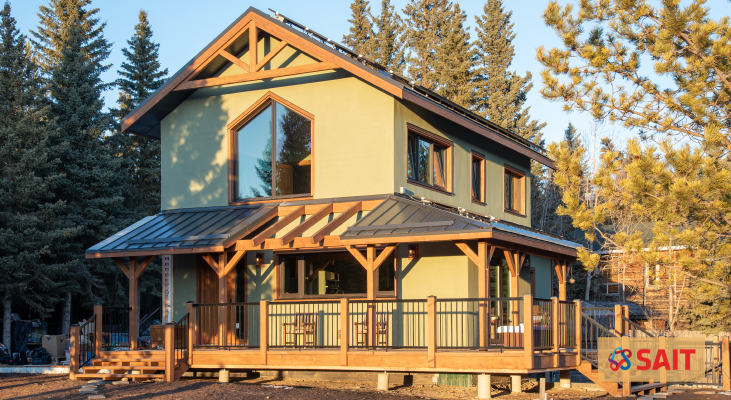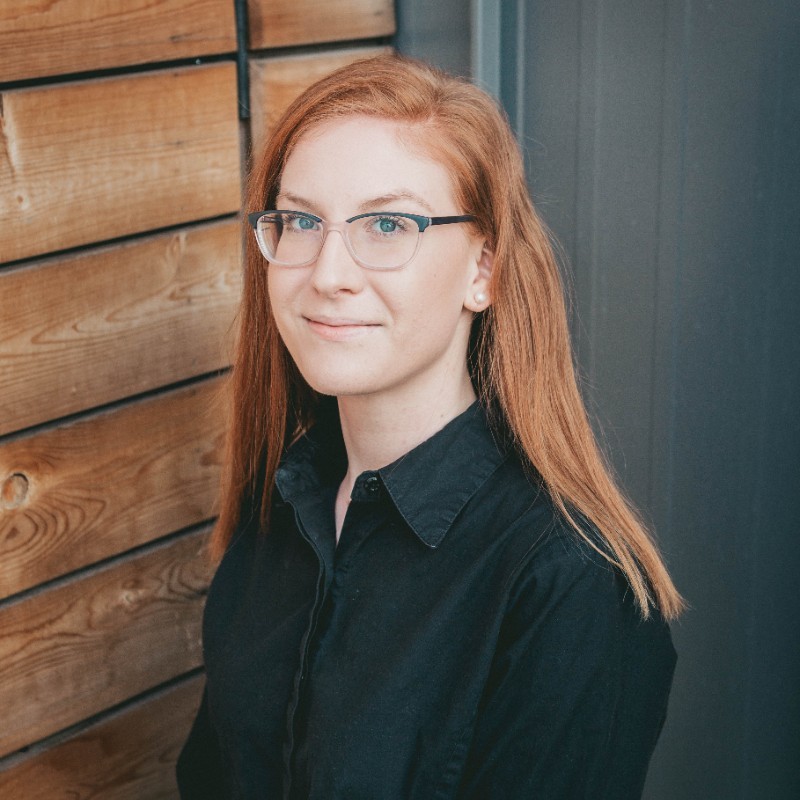A combination of applied research expertise and climate-aware programming enables polytechnics to take a leadership position for the transition to cleaner, greener infrastructure. A case in point, SAIT’s Green Building Technologies research division recently completed work on The Confluence – a green tech home built in partnership with Woodpecker European Timber Framing that produces more energy than it consumes. The Confluence is posed to achieve the Living Building Challenge’s highest certification.
Polytechnics Canada sat down with Melanie Ross, the project’s research manager and Hayley Puppato, one of its coordinators, to discuss the effort.
Polytechnics Canada: How did your Green Tech project come about?
Hayley Puppato: The Confluence came together with an integrated project management team of SAIT’s Green Building Technologies (GBT), Woodpecker European Timber Framing and the homeowners. The homeowners, Gerton and Joleen Molenaar, decided to build a dream home but were concerned about the toxic materials conventionally used in construction. Non-toxic materials and energy security became critical to their dream home, and these values aligned with the Living Building Challenge (LBC) from the International Living Future Institute. GBT helped research and meet program requirements, and Woodpecker built the traditional timber-framed home.
Melanie Ross: GBT focuses on industry transformation through innovative research projects and education. This project met our criteria, with many areas for innovation and a collaborative and open team that has actively shared lessons, worked through challenges and welcomed new, and sometimes ‘out there,’ ideas.
PC: Woodpecker European Timber Framing was your industry partner on the project. Do you have a sense of what they and SAIT each took away from the project?
HP: I believe everyone who worked on this project really gained an appreciation of the environmental considerations that should go into construction. LBC requirements are quite stringent and everyone on the project put in a lot of time and effort to see The Confluence succeed. SAIT’s project team brought a lot of determination and resourcefulness to their research, originally underestimating the non-toxic building material research. Grit and resolve to complete this project left us with the tools, resources and a list of approved non-toxic products that will be extremely useful in future endeavors.
MR: It has been interesting to see which areas emerged as more challenging and harder to achieve than others. We have been able to demonstrate where the construction industry is doing well (energy efficiency, for one) and where it lags (material transparency and regional availability, as examples). We have also gained valuable insight into integrated design and construction strategies, and how to navigate the constant challenges of a program like LBC.
PC: What was the student involvement on this project? What green skills will learners be able to take with them into their careers?
HP: There was a huge student involvement on this project – 20+ students worked on The Confluence over the past five years in practicum and capstone projects. Students from many different programs participated, including Environmental Technologies, Architectural Technologies, Software Development, Web Development, Film & Video Production, Civil Engineering Technology, and Engineering. Every student had practical experience in their respective sectors, and learned about what makes The Confluence so special. Of the practicums and capstones that I oversaw, the Environmental Technology students learned about the LBC program, native and naturalized plant species, alternatives to petrochemical pesticides and fertilizers, and standards for ‘green’ cleaning products. They practiced conducting a Phase I Environmental Site Assessment, undertook soil sampling and analysis, and learned about carbon offset programs. These students will take that technical knowledge and practical experience into their careers.
MR: We are very fortunate be part of an institution that values applied learning. The GBT team gained mentorship experience and benefitted from the hard work of students on the project. It is inspiring to know we are developing knowledgeable and experienced sustainability professionals who will carry the work forward in their respective careers.
PC: How do you predict your work will influence the future of construction in Canada?
HP: I hope that our work broadens the views and values of those working in the construction industry – from suppliers and manufacturers to the trades and homeowners. We’re starting to see a shift in the market for non-toxic building materials, energy conservation, energy generation and energy storage. There’s still a long way to go in terms of enabling industry to first be sustainable and then regenerative. Everyone at GBT is promoting the shift with every project and conversation.
MR: This project has inspired many to reach out to learn how to apply the LBC strategies to their own homes, businesses, practices, education programs and so on. We have started a dialogue around what is achievable in our industry, raising the profile of resiliency and environmental consciousness. Our next steps include taking the knowledge we’ve gained and sharing it to inform other projects and industry improvements.
Learn more about SAIT’s Green Building Technologies Projects.



